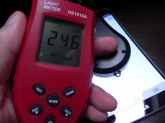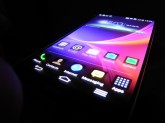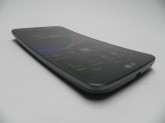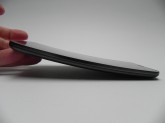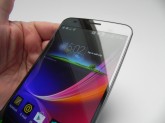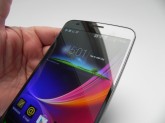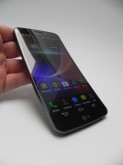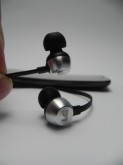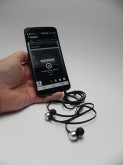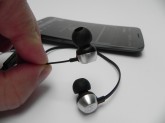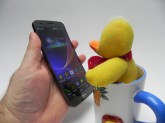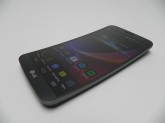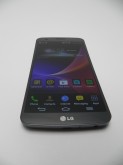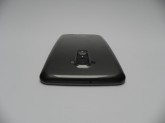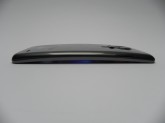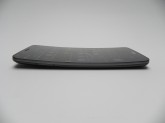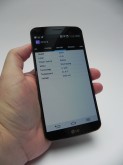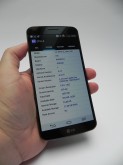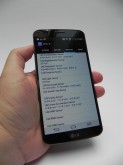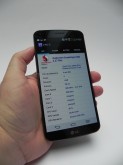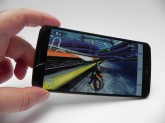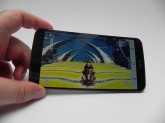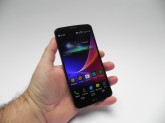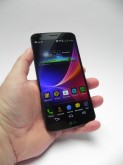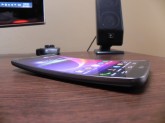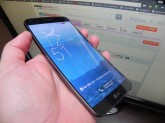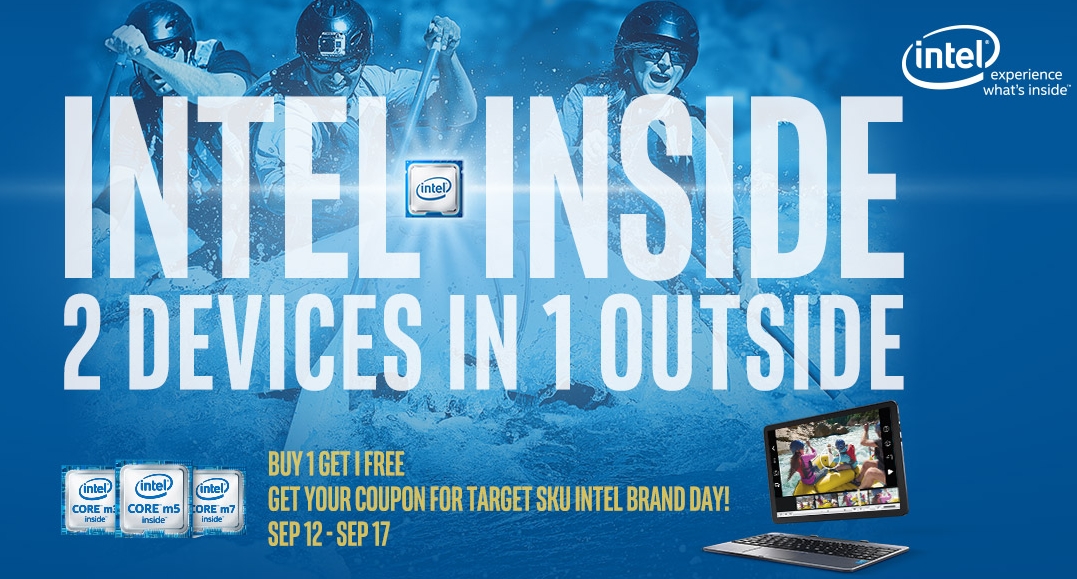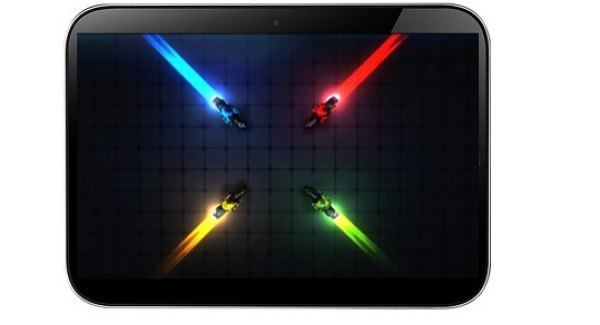The LG G Flex is the first curved phone that we ever tested and it has both a curved body and a curved display. This model was launched internationally in November and it’s priced at $650 on Amazon off contract or $300 on contract. This is the start of the curved phone trend, so this is an important device.
The handset measures 8.7 mm in thickness, weighs 177 grams and seems to be very slim, in spite of these figures. We’ve got a 6 inch device here, that’s able to flex only a little bit, as shown in the video below. Actually, the device only flexes when placed on a surface, not in mid air. The point is that if you have this device in your back pocket and you sit down, it should be able to bend and survive it.
Also, LG praises its self healing ability of the back surface of the smartphone. We did scratch the back of the device with a key, but the scratch was not gone as promised, sadly. I’ve heard that it needs to be subjected to light or heat, but even that didn’t work. That’s why I find both the flexing and auto healing gimmicks in my books and not real features.
The design reminds me of a bigger LG G2 and we’ve got the same back button setup, as on the flagship launched at the end of the summer 2013. This time we get better button feedback, luckily and a screen bezel that’s very thin and very likable. The curve of the device makes holding it easier and otherwise, it’s a pretty slippery device.
I have to mention that the Power key tends to light up and now having a glance at the entire design, we find at the back the camera, infrared and LED side by side next to the sensor, the physical buttons and speaker. At the bottom there’s the audio jack, microphone and microUSB port. At the top there’s another microphone, while at the front we’ve got the notification light, earpiece and sensors.
On the left side rests a microSIM card slot and I have to say that the curvature of this model perfectly fits the user’s face, so the phone calling is done perfectly, without hassle for hours. Why? Because the mic is closer to the mouth… By the way, this model has a glossy back, that’s a bit of a dust magnet and overall this feels like an interesting experiment and I like this format.
On the hardware side we’ve got a 6 inch 720p display, a POLED unit with Gorilla Glass protection and RGB panel. The CPU inside is a quad core Snadpragon 800 clocked at 2.26 GHz, with Krait 400 cores. We’ve got an Adreno 330 GPU on board, 32 GB of storage, of which 24 GB are available and there’s no microSD here.
LG G Flex relies on 2 GB of RAM, a 13 MP back camera, a 2 MP front shooter and on the connectivity side we’ve got all the possible options: quad band GSM/GPRS/EDGE, LTE, HSDPA (42 Mbps), WiFi dual band, WiFi Direct, DLNA, Bluetooth 4.0, NFC, infrared, microUSB 3.0, with USB Host support, USB on the Go and Slimport.
Finally, there’s GPS and Glonass and other features include an accelerometer, proximity sensor and a big Li-Polymer 3500 mAh battery. This is a 13.3 Whr 3.8 V battery, that’s supposed to be flexible according to LG. In our test, involving continuous HD playback with WiFi on and brightness at 50% we achieved 12 hours and 15 minutes of playback. The battery takes 2 hours and 7 minutes to charge, which is very OK. Overall, this is a very good battery, that beats the LG G2 functioning time by about 3 hours.
On the audio side, know that there’s no FM radio and on the bright side we’ve got a pair of nice looking Quad Beatz headphones, of the highest quality. The speaker at the back and headphones offer a high volume and excellent bass. The earbuds are identical to the ones of the LG G2 and the experience and the audio player are also the same. The player offers a bunch of EQ settings, including custom one and just like the LG G2, this model does HiFi audio playback, with support for 24 bit 192 KHz music.
By the way, the speaker at the back has a slight tendency to get muffled, even though the phone is curved. On the video side, we’ve got a plastic OLED screen, made by LG and relying on a plastic substrate, that’s flexible. This 6 inch screen has a 720p resolution and a pixel density of 245 ppi. The display offers a full RGB matrix and the video player on board of the device provides pinch to zoom while watching video, track zoom and a variety of settings. The image is crisp and reasonably bright, at 246 Lux units on white, although I would have expected more.
This is about half of the brightness that the HTC One provides, by the way. Also, the LG G Flex doesn’t behave that well in sunlight, since it reflects a lot of the light. Still, the device is great for video watching, because of its curved format, just like the IMAX screen. The brightness could be better, but at least the view angles are good.
There’s a slight oversaturation here, that can be tweaked a bit in the Settings, in the Screen Mode area. We’ve also got some special options for the screen use, like Smart Screen, that detects your face and keeps the screen on and Smart Video, that puts a video on pause when there’s no face sensed. Overall, this is a slightly disappointing screen. As far as the camera goes, this is basically 90% of the LG G2 experience and totally the same interface.
LG G Flex takes 4160 x 3120 pixel pictures, using a 13 megapixel sensor with F/2.4 aperture. This camera hasa 3.97 mm equivalent focal length and unlike the LG G2, there’s no optical image stabilization here. The UI is the same as the one of the LG G2, including flash options and settings on the left side, as well as the famous LG modes. The Modes include Shot + Clear, that removes objects from the frame, HDR, Panorama, VR Panorama (360 degree), burst shots, dual camera, time catch, intelligent auto, sports and night.
[youtube 6YXxULToP3c 660 520]
Time catch takes a few shots before you press the shutter button, while intelligent auto will automatically figure out the scene mode you need. The Settings area includes options like Cheese, Exposure, focus, size, ISO, white balance, color effect and a few video options. Zoom is taken up to 8X and now going to the gallery, the pics we’ve taken have a very good level of detail, but I have to say that the colors are oversaturated.
[youtube A0qhvFgx5iM 660 520]
We’ve got a good white balance, crisp image, but some pictures will be blue-ish when you’re surrounded by snow. Panoramas are OK, the close ups are decent and HDR is very good. Low light pictures, like those taken under that bridge were very detailed and well done, so at least low light is covered and the flash is pretty good. The video capture is done in 1080p at 30 or 60 FPS and there’s also 4K video capture. The resulting file is an MP4 with 30 Mbps bitrate and audio at 96 Kbps.
[youtube GkFROqm9QpE 660 520]
We’ve got tracking zoom, that only focuses and zooms in on a certain area in your field of view. The audio zoom is a disappointment and overall the video quality is good, the details are nice and colors are oversaturated. Exposure is good and the 4K capture looks fantastic even when you zoom in during capture. Aside from the oversaturation, blue hue and no OIS, this is a very good camera, but those lacks can’t be ignored! And here you can see the full gallery of pics we snapped.
[youtube 5yALwZ_sydc 660 520]
LG G Flex reaches a temperature of 37.8 degrees Celsius after 15 minutes of Riptide GP2 gaming, which may sound OK, but in real life the device gets quite hot after a while. By the way, there’s also a bit of creaking when you bend the device, that may annoy you, since it happens often. The web browser provides great speed and pinch to zoom works without flaw. As far as benchmarks are concerned, I decided to compare the LG G Flex with the LG 2 and Galaxy Note 3, since they share the same Snapdragon 800 CPU.
In Quadrant we scored 20.493 with the G Flex, beating the LG G2 and its 17k points, while the Note 3 beats it with 21k points. In AnTuTu we scored 35836 points, beating the 35700 of the Note 3 and 33k of the LG G2. In NenaMark 2 we went past the G2 with 59.9 FPS versus 58.7 FPS, whole Note 3 got 60.3 FPS. In Vellamo we achieved 2979 points and once again we beat both rivals. In 3DMark we got 12k points and got beaten by both rivals by thousands of points.
Finally, in BrowserMark 2.0 there’s a score of 2665 points, less than both the G2 and Note 3, but still the browser speed was great. The score differences were not that big between these models, keep that in mind. Then we had a look at the notification area, with its shortcuts to the Quick Memo feature, the Quick Remote, Q Slide floating apps and other connectivity shortcuts.
We got some gestures available as well, like the double tap on the screen to unlock the device and the Settings area also gives us interesting stuff like the one hand operation, multitasking with 3 finger swipes to pull an app into a tabbed area and also a 50/50 screen division to use two apps on two halves of the screen. LG G Flex also comes with a few preinstalled applications that you may find interesting.
Those include LG Backup, Life Square, Google Maps, Memo and Notebook, that’s a lite replacement of the S Note application on the Galaxy Note series. We’ve also got Q Theater, which is basically a visualizer of pictures and videos like the one from the 3D display handsets area. We’ve got a Quick Remote to control a TV set or Blu ray player, Tasks, Box for cloud storage and Dictionary. Finally, there’s a file manager and Polaris Office is also preinstalled.
LG has its own app store preinstalled here, the LG Smartworld, that has a few interesting games like SSX for example. The OS here is Android 4.2.2 and as far as phone call is concerned, the curved form factor is actually helpful and offers a great call experience. And now for the Pros and Cons.
These are the Pros:
- more comfy than other 6 inch devices
- perfect audio
- nice video capture
- good performance
- lots of camera features
- nice video experience because of curved display
And the Cons:
- self heal and flexing are gimmicks
- speaker gets slightly muffled easily
- screen disappoints
- 720p screen
- sunlight behaviour of screen
- blue-ish huse on pictures
- no FM radio
- case creaks
- bloatware apps
- Android 4.2 only
- big price
LG G Flex gets from us a 7.8 out of 10 for design, an 8 for hardware and an 8.8 for OS and UI. The final grade is 8.2 out of 10 and this is still a very good device, if you want to try something new, that feels like a prototype. It’s a curved handset with an unique experience, that may not be for everyone.
[youtube 8diS3skw5rE 660 520]
Post Footer automatically generated by Add Post Footer Plugin for wordpress.











